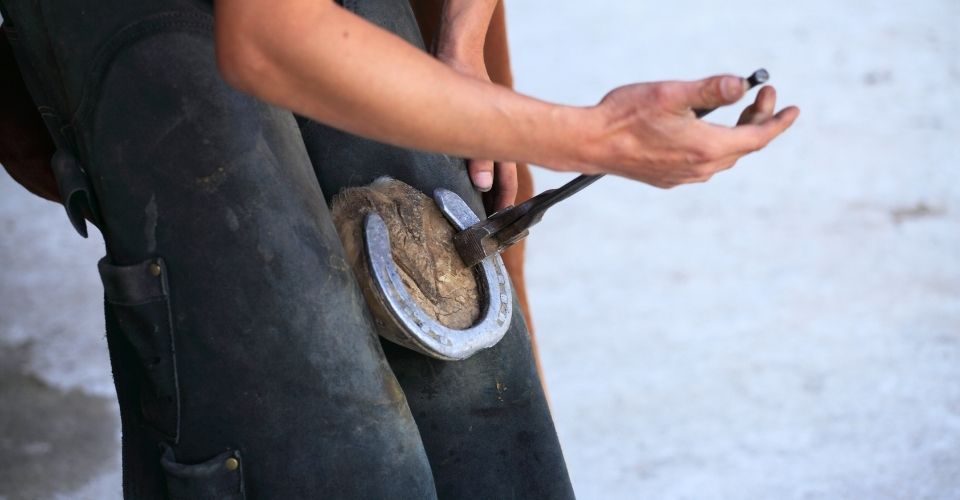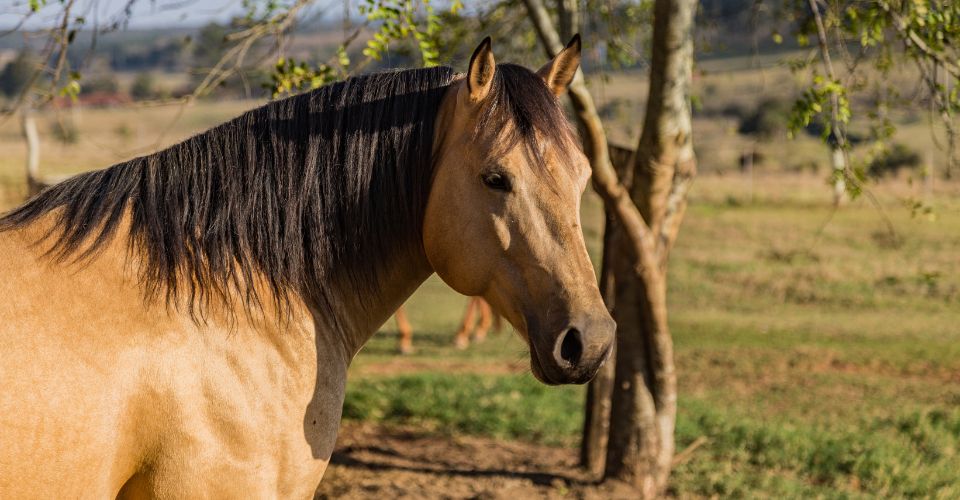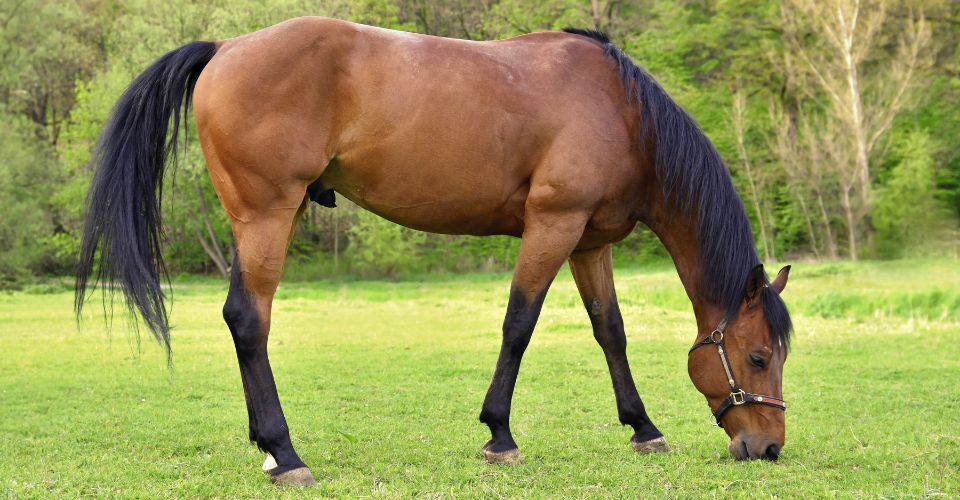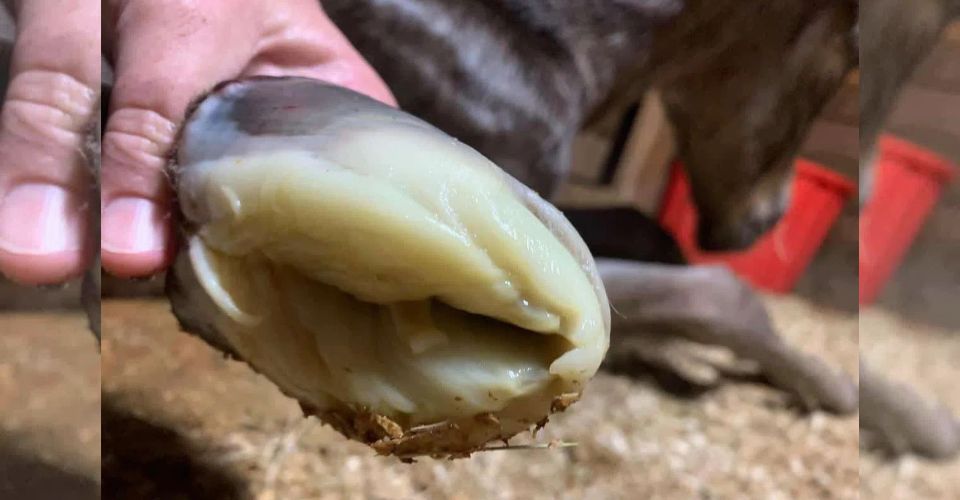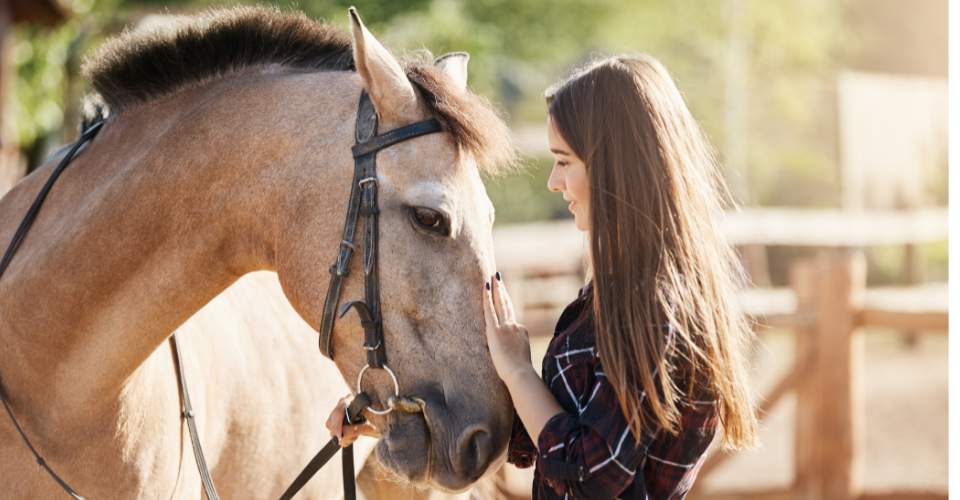Ever wondered why horses wear shoes? Well, for the same reason we humans do! Of course, they don’t look anything alike, but the purpose is the same. Horseshoes are aimed to guard the horses’ hooves the same way our shoes protect our feet.
For decades, people have explored diverse methods to cushion their horses’ hooves. From Asia’s woven hoof booties to Roman metal sandals, tending to horse hooves has been here for thousands of years. Horseshoeing became popular in Europe around 1000 AD, yet no one knows when the first metal horseshoe with nails was made.
Horseshoes became popular as a means of protecting horses’ hooves in harsh environments after they were domesticated. Many horse breeds were not reared with hoof strength, resulting in weaker hooves in some breeds. Horses in good condition, on the other hand, do not require horseshoes and can ride barefoot.
Why Do Horses Need Shoes?
Horseshoes are quite ubiquitous, it’s unusual to meet someone who doesn’t know what they look like. But why are they a thing in the first place? And why do practically all horses (except wild horses) wear them? Why do horses need shoes?
The reason why a horse wears shoes differs depending on the horse’s health, activity levels, and the environment in which they are kept. Below are a few reasons why do horses need shoes.
Protection
Horseshoes are vital for hooves that are frequently in contact with rugged terrains, such as concrete, mountains, or other rough surfaces. Riding on rutted or stiff flooring can put horses in danger of stepping on objects that may harm their natural hooves.
Durability
Horseshoes are used to improve the durability of a working horse’s hoof. Keratin, the same material that makes up our fingernails, also makes up the horses’ hooves. However, it has a sensitive and tender inner component called the frog that can nevertheless be harmed. When horses move, the hoof naturally wears away; therefore, attaching a shoe to the hoof helps to reduce this and maintain the frog healthy.
Medical Reasons
Sometimes, medical reasons, such as laminitis, arthritis, or ringbone may also precipitate a horse to wear shoes. Wearing shoes ensure that the disease do not get worse. Besides, horses feel more comfortable to work in shoes, especially when there is something wrong with their feet or hooves.
Performance
Lastly, the performance. Wearing shoes improves the performance of horses. This is why you would often see majority of riding horses with shoes.
What Are Horseshoes Made Of?
Now that you know why do horses need shoes, let’s discuss what are horseshoes made of.
Typically, horseshoes are made of steel or aluminum and are attached by nailing the shoe to the horses’ hoof. These materials are sturdy and can maintain their shape, but the style of a horseshoe that your horse needs will largely depend on its breed.
Some horse breeds use different shoe styles on their front legs than they have on their hind legs. It’s not uncommon for the hind legs to be fitted with a horseshoe, otherwise known as a caulk, which includes extra steel materials to prevent excess wear-and-tear damage.
Horse hoofs are similar to human nails in appearance, although they are much thicker. The horseshoe is frequently nailed into the thick, unfeeling section of the horse’s hoof by farriers. While the horse’s hoof is extremely sensitive in the core, the outside is completely painless. The farrier may choose to glue the shoe on instead. If you’re riding in muddy circumstances, be aware that your horse’s shoes may fall off.
How Horseshoes Are Put On the Horse?
Those who install horseshoes on horses are called farriers (also spelled Ferrier). Farriers attach the horseshoe to the hoof with nails. As previously stated, horses’ hooves are made of the same material as your nail, and the horses do not feel anything when the horseshoe is affixed to the hoof, just as you do when you cut your nails.
After the nails are driven through the hoof’s outside edge, the farrier bends them over to form a hook. The sharp points that remain, as well as a portion of the hoof, will be filed away to guarantee a suitable fit. When the hoof grows long enough, it will eventually overlap the shoe, signaling that they need to be re-shod.
How to Shoe a Horse Step by Step?
Following are the steps to shoe a horse.
- The first thing you should do is to wipe your horse’s hooves of any dirt or debris.
- Remove any superfluous sole from the bottom of the hoof with a hoof knife.
- Trim the superfluous hoof wall to the proper length with hoof nippers.
- Even out the hoof using a rasp.
- Determine your horse’s shoe size.
- Align the shoe with the horse’s hoof’s edge.
- The nails should be hammered in at an outward angle so that the nail tips protrude through the hoof wall.
- Bend and remove the nail tips with the claw of the hammer.
- Pinch the nail ends together with a clincher.
- Even the outside of the hoof with a rasp.
Types of Horseshoes
Questions arise in our minds about why do horses need shoes? Do horseshoes also have types like human shoes? What do they look like?
There are several types of horseshoes, each suitable for different needs.
The most common types of horseshoes are regular, rim, bar, egg bar, and heart bar.
Regular
This is the most prevalent type of horseshoe, and the majority of riding horses wear it.
Rim
This type of horseshoe has a deep groove in the center that gives extra traction and is widely used in barrel racing.
Bar
It has a bar at the heel that gives additional stability.
Egg Bar
It has a bar that extends beyond the heel and is commonly used on horses with navicular disease.
Heart Bar
It has a bar at the heel as well as a frog support component, and it’s widely used on horses with laminitis.
Do Horseshoes Hurt Horses?
Many people are afraid that because horseshoes are fixed directly to the hoof, applying and removing them will be traumatic for the animal.
However, the tough part of a horse’s hoof contains no nerve endings, so this is a completely painless procedure. The horses show no signs of discomfort or aggression because the horse will have a sensation comparable to that of having our fingernails clipped!
Horseshoes do not harm horses when properly fitted and applied.
Should You Shoe Your Horse?
Shoeing is unlikely to be necessary for most pleasure horses. Proper care, including regular trimming, may be all that is required. As you ride over various types of terrain, you must pay attention to the wear on the hoof and the comfort of your horse. If your horse’s hooves are hurting, you have a few options.
Your horse may require special protection, such as hoof boots that can only be worn while riding. You can also go for traditional nailed-on shoes. Some people consider glued-on shoes to be more compassionate. Your farrier is the finest source of information on what type of foot protection your horse may require.
Although barefooting is preferred for horses, there are situations when shoes are required. Horses that draw a lot of weight need shoes to keep their hooves from getting worn out. Racing horses with weak hoof or leg muscles are frequently protected with shoes. They’re also used to provide more traction for horses in the snow and ice.
Some individuals have idealistic but incorrect views about how horses don’t require shoes in nature, that shoes are “malevolent,” and that people put shoes on horses without considering “the barefoot option.” Some horses, after all, simply require footwear. Others, however, do not. And you can assure that the owner considers it every seven weeks when he or she receives that invoice.
The Dangers of Horseshoeing
Shoeing is considered the cause of many problems by barefoot advocates, and indeed, negligent shoeing can cause more harm than good. Shoeing, on the other hand, provides numerous advantages as well. It’s up to you and your horse to decide whether or not going barefoot is the best option.
The majority of farriers are excellent at what they do, yet mistakes can arise. The nails used in horseshoeing might further injure the horse’s hoof if it is brittle or broken. When the nails are put wrongly, the horse suffers pain, and the soft tissue in the hoof gets damaged. When the horse walks, an incorrectly placed or fitted shoe can cause injury, similar to the problems that occur when humans wear shoes too small.
Functions That Horseshoes Interfere With
Traction
Iron is a lot more slippery than hoof wall and frog on most surfaces, especially pavement.
Blood Circulation
Circulation of blood. There are two phases to every stride: Weighted and unweighted. When a horse’s bare hoof strikes the ground, and the horse’s weight falls directly on it, the hoof capsule deforms and expands somewhat, creating a suction that draws blood into the small capillaries. It contracts again as the horse travels and picks up the foot.
The blood is pushed back up the leg to the heart as a result of this. This benefits both the hoof and the heart by minimizing the amount of work it has to do. Because shoes prevent the hoof from expanding and changing shape, this function is disabled.
Shock Absorption
The energy of the hoof striking the ground is absorbed by the blood flow. On the same footing surface, a shod horse’s leg absorbs more shock at the walk than a barefoot horse’s leg absorbs at the trot. That puts a lot of strain on the joints. Because iron is harder than hoof, the shoes directly increase concussion, and the disabling of the expansion function prevents the shock energy from being absorbed hemodynamically.
Hoof Growth
“However, without shoes, my horse’s feet will deteriorate too quickly!” No, when they’ve been conditioned, they won’t. A hoof is a living, growing body organ, not a block of wood. Remember how barefoot horses have better blood circulation? It promotes the development of the hoof wall! What a concept! After completing a 50 or 100-mile ride in one day, barefoot endurance horses must have their feet trimmed within a few days. All of this exercise encourages a healthy, sound, and properly conditioned hoof to grow faster.
Tough Soles
Riding on rocks? Since shoes just cover the edge of the hoof wall, they do not protect against rocks. A shoe’s 1/4 inch of elevation isn’t enough to protect the sole or frog from 2-inch rocks. Riding on a diversity of surfaces and allowing the horse to move freely will prepare the horse’s hooves to respond to the work required of them and build up the tough callouses that will protect them from stones and other injuries.
Proprioception
The horse’s bare hoof is loaded with nerves that alert it to what it’s walking on. A shod hoof’s restricted circulation also affects nerve function and sensory feedback. A barefoot horse detects a rock under its foot considerably sooner than a shod horse and can change its stride to unweight that foot before putting its entire weight on it, avoiding a bruising.
Development of the Internal Structures of the Hoof
With shoes on, the lateral cartilages and digital cushion cannot develop properly and may even be damaged after full development due to increased concussion. Yearling Thoroughbreds are commonly shoed to make them appear more mature at sales, so buyers and sellers may ignore the fact that they’ll be asking these youngsters to undertake an adult job in a few months, many years before their bodies are mature enough.
Development of Thick, Strong Hoof Wall
Again, if the hoof was never given the opportunity to properly mature, it will always be weak. Unless you give it a proper barefoot trim rather than a regular farrier’s shoe prep trim, as well as focus on diet, regular free movement, and occasionally hoof boots throughout the transition.
The Ability of the Hoof to Reject Foreign Objects
Between the shoe and the frog, rocks frequently become stuck. Without a shoe, there’s one less location for things to get jammed. Snow will also pack into a shod hoof, forming an ice ball. Instead of standing on a flat, stable surface, the horse is now teetering on a round, hard-packed ball. The ice is also extremely slick.
All of these advantages necessitate a little more effort on the part of the owner, as well as significant adjustments in the way some individuals manage their horses. Unless you use hoof boots, you can’t have a barefoot horse standing on soft shavings 24 hours a day and then take it out for an 8-hour ride on tough trails on the weekends and expect it to be sound.
With boots on, the hoof can still perform what it’s designed to do, and unlike iron shoes, they protect the hoof from injuries by covering the sole. If you consider how much time and effort is saved by not having to muck stalls if the horse is pastured, you’ve just achieved significant time and effort savings.
Another advantage of owning a barefoot horse is that when they tread on your foot (Ouch!), it is not nearly as painful as it would be if they were wearing shoes.
This article extensively covered why do horses need shoes. Which horses need shoes and which do not? What types of shoes do they wear? What are the benefits? What are the drawbacks? If you are interested in more of such articles, head to our Horse Section, where we talk about all things horse owners need to know.

